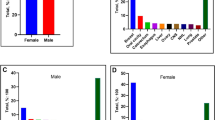Abstract
Objective
To improve the care of cancer patients by understanding the factors associated with the place of death.
Patients and methods
We conducted a retrospective study of death certificates registered in Mexico during 2003. Adult cases were included if the underlying cause of death was cancer, death location was in the Mexico City Metropolitan Area (MCMA), and information was available on sociodemographic characteristics and place of death (home or medical unit).
Main results
Of the 10,561 cases meeting the inclusion criteria, 54% died at home. More women (55%) than men died of cancer and at a younger age (63 vs 64 years, respectively; p < 0.001). Multivariate analysis indicated that patients diagnosed with leukemia and lymphoma were 3.6 times more likely to die in hospitals than patients diagnosed with other cancers (p < 0.001). Compared with patients who died at home, patients who died in hospitals were significantly more educated, younger, and residents of counties with more hospital beds density (p < 0.001, p < 0.001, and p = 0.003, respectively). Certificates for in-hospital deaths were more likely to be signed by other physician or health professional than were those for at-home deaths (p < 0.001). Cases with usual residency located outside the study area were 27 times more likely to die in hospitals than were metropolitan-area residents (p < 0.001).
Conclusions
Patients dying at home tended to be of older age, less educated, diagnosed with prostate, urinary tract or gastrointestinal cancers, and residents of the MCMA. Health planners should consider determinants of place of death when allocating hospital or home-based palliative care units.

Similar content being viewed by others
References
Aabom B, Kragstrup J, Vondeling H, Bakketeig LS, Stovring H (2005) Population-based study of place of death of patients with cancer: implications for GPs. Br J Gen Pract 55:684–689
Addington-Hall J, Altmann D, McCarthy M (1998) Which terminally ill cancer patients receive hospice in-patient care? Soc Sci Med 46:1011–1016
Anonymous (2000) XII Censo General de Poblacion y Vivienda, vol 2005. Instituto Nacional de Estadistica, Geografia e Informática, Mexico, DF
Anonymous (2001) Acciones Hoy, Para Mexico Del Futuro Programa Nacional de Salud 2001–2006. In: 2001–2006 PNdS (ed) La Democratizacion de la Salud en Mexico. Hacia un Sistema Universal de Salud. Secretaria de Salubridad y Asistencia, Mexico, DF
Anonymous (2001) Programa de Población del Distrito Federal 2001–2006, vol 2005. Gobierno del Distrito Federal, Mexico, DF
Anonymous (2006) International observatory of end of life care, vol 2006. Institute for Health Research Lancaster University, Lancaster, UK
Bauduer F, Capdupuy C, Renoux M (2000) Characteristics of deaths in a department of oncohaematology within a general hospital. A study of 81 cases. Support Care Cancer 8:302–306
Brooks S, Chen T, Ghosh A, Mullins C, Gardner J, Baquet C (2000) Cervical cancer outcomes analysis: impact of age, race, and comorbid illness on hospitalization for invasive carcinoma of the cervix. Gynecol Oncol 79:107–115
Bruera E, Russell N, Sweeney C, Fisch M, Palmer L (2002) Place of death and its predictors for local patients registered at a comprehensive cancer center. J Clin Oncol 20:2127–2133
Bruera E, Sweeney N, Russell JW, Palmer L (2003) Place of death of Houston area residents with cancer over a two-year period. J Pain Symptom Manage 26:637–643
Cardenas-Turanzas M, Grimes RM, Bruera E, Quill B, Tortolero-Luna G (2006) Clinical, sociodemographic, and local system factors associated with a hospital death among cancer patients. Support Care Cancer 14:71–77
Costantini M, Camoirano E, Madeddu L, Bruzzi P, Verganelli E, Henriquet F (1993) Palliative home care and place of death among cancer patients: a population-based study. Palliat Med 7:323–331
De Conno F, Caraceni A, Groff L, Brunelli C, Donati I, Tamburini M, Ventafridda V (1996) Effect of home care on the place of death of advanced cancer patients. Eur J Cancer 32A:1142–1147
Foley K, Gelband H (2001) Improving palliative care for cancer. Institute of Medicine and National Research Council, Washington, DC
Gallo W, Baker M, Bradley E (2001) Factors associated with home versus institutional death among cancer patients in Connecticut. J Am Geriatr Soc 49(6):771–777
Ghafoor A, Jemal A, Ward E, Cokkinides V, Smith R, Thun M (2003) Trends in breast cancer by race and ethnicity. CA Cancer J Clin 53:342–355
Izquierdo-Porrera A, Trelis-Navarro J, Gomez-Batiste X (2001) Predicting place of death of elderly cancer patients followed by a palliative care unit. J Pain Symptom Manage 21:481–490
World Health Organization (1992–1994) International statistical classification of diseases and related health problems, Tenth Revision, vol 1–3. WHO, Geneva
Silvi J (2003) On the estimation of mortality rates for countries of the Americas. Epidemiol Bull 24:1–5
Unknown (2001) Egresos hospitalarios por capitulo de causa, segun sexo, vol 2005. Direccion General de Informacion en Salud, Mexico, DF
Unknown (2002) Directorio de Unidades Medicas, vol 2005. Direccion General de Informacion en Salud, Mexico, DF
Unknown (2003) Mortalidad, vol 2005. Direccion General de Informacion en Salud, Mexico, DF
Unknown (2004) World Health Organization supports global effort to relieve chronic pain. World Health Organization, Geneva
Weitzen S, Teno JM, Fennell M, Mor V (2003) Factors associated with site of death: a national study of where people die. Med Care 41:323–335
Author information
Authors and Affiliations
Corresponding author
Rights and permissions
About this article
Cite this article
Cárdenas-Turanzas, M., Carrillo, M.T., Tovalín-Ahumada, H. et al. Factors associated with place of death of cancer patients in the Mexico City Metropolitan area. Support Care Cancer 15, 243–249 (2007). https://doi.org/10.1007/s00520-006-0152-4
Received:
Accepted:
Published:
Issue Date:
DOI: https://doi.org/10.1007/s00520-006-0152-4




